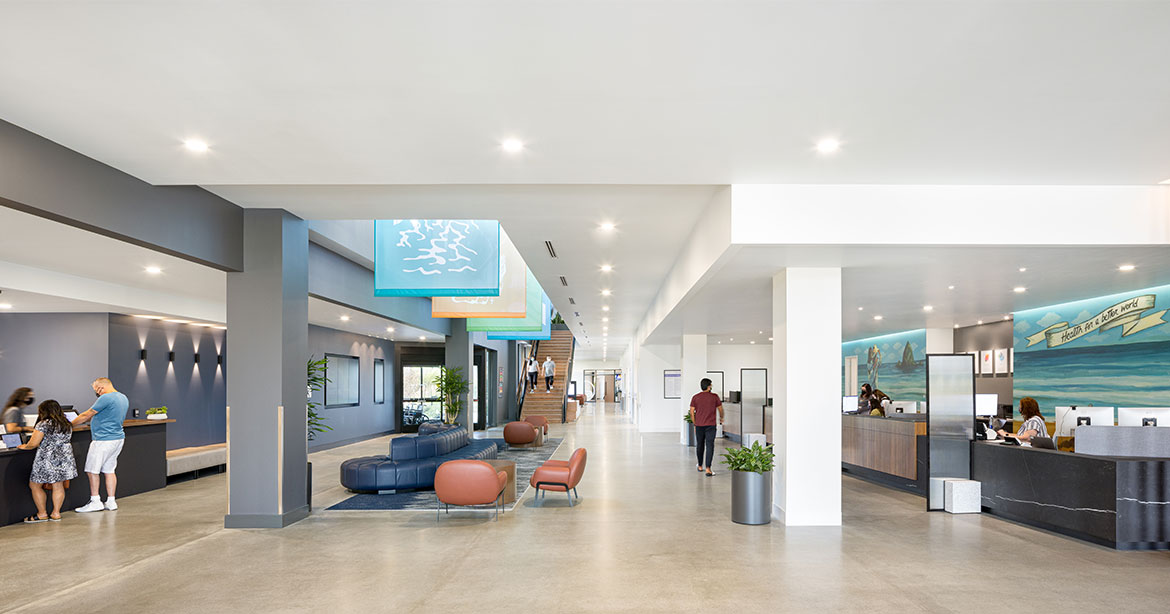
There is a continued shift towards prevention-focused care and wellness in healthcare. Why is this happening, and what can healthcare systems do about it?
The background is rooted in both business and the community. The Affordable Care Act (ACA) changed the healthcare reimbursement model. Under the previous model, hospitals and health systems benefited from how many sick people they treated. After the implementation of the ACA, systems benefited more from the number of well people in their community.
“Healthcare systems are starting to think about ways to work with patients in the community before they get sick,” says Julie Crawford, healthcare market executive at Mortenson. “Therefore, we’re seeing an increase in wellness centers being built and staffed by hospitals. Investing in wellness centers is about more than business models. Systems and their staff want to take a more proactive approach to taking care of people in the community.”
Incorporating Services and Amenities That Promote Health and Wellness
Community studies often help health systems identify trends in the areas they serve and plan their healthcare facility construction around addressing specific public health problems. While the needs differ from community to community, there is some overlap in the services and amenities offered at wellness-focused healthcare facilities:
- Fitness centers, often with yoga or meditation spaces to promote mind-body wellness
- Nutrition services to promote healthy eating and address food insecurity
- Public green spaces to provide respite for staff, patients, and the community
- Behavioral and mental health services in response to the mental health crisis
- Outpatient addiction treatment and support centers
- Eldercare and day programs for aging communities
Providence Health Center-Reed's Crossing in Hillsboro, Oregon, focuses on integrated health, with an emphasis on preventing chronic illness. The newly constructed facility hosts a 45,000-square-foot active wellness center and a 65,000-square-foot clinic providing urgent care, imaging, women’s health, and dermatology services. The location was chosen for its proximity to a community of single- and multi-family homes, and senior living units. “Wellness-focused facilities are a critical part of the healthcare ecosystem,” says Chantily Malibago, director of real estate. “They’re intended to be integrated into the community and in the path of travel for consumers.”
(left) Providence Health Center-Reed’s Crossing combines primary and urgent care health services with wellness-focused amenities. (right) Community members utilize the facility’s fitness center.
While new construction is always an option, Fairview’s Community Health and Wellness Hub in St. Paul, Minnesota, demonstrates how healthcare systems can repurpose existing facilities to accommodate wellness efforts. Fairview built the Wellness Hub as part of an effort to provide the community with responsive, equitable, and accessible healthcare. The 100,000-square-foot campus addresses health disparities and provides critical services, including low- and no-cost primary care, outpatient mental health and addiction services, an adult day program, and drive-up and mobile food access to address food insecurity.
Julie explains “The closing of a neighborhood hospital left a bit of a vacuum for the folks who were accustomed to going there for care. Fairview repurposed the building and developed an intentional care alternative that addressed the specific needs of the community.”
These projects demonstrate the possibilities of creating wellness-focused healthcare spaces. However, it’s understandable that such a large undertaking can seem overwhelming, especially for smaller organizations or those having trouble securing funding. When budgets are tight, it’s good to remember that not everything needs to happen at once. Organizations can phase their construction and renovation projects, focusing on critical services first, then slowly building on their programs as time and budgets allow.
Creating Patient-Centered Healthcare Facilities
Having the right services and amenities is just part of creating a wellness-focused care facility. To best serve patients and the community, organizations should also prioritize these key areas in their construction plan:
- Better patient experiences. Improving the efficiency and flow throughout a healthcare facility makes care delivery easier for both patients and staff. Designs should focus on creating welcoming, accessible spaces that are easy to navigate.
- Focus on collaboration. A large part of wellness and prevention is improving communication among different care teams. Incorporating collaborative spaces helps bring providers together to share ideas and inspire innovation in patient care delivery.
- Staff well-being. Burnout is a very real issue in healthcare. Respite areas and ample access to fresh air and green spaces improve the health and well-being of staff and care providers, which helps promote a better overall patient experience.
- Adaptability. Configurable spaces allow facilities to respond more easily to changes in care delivery models as a community’s healthcare needs evolve.
Building a healthcare facility focused on whole person care involves creating spaces that promote healing, collaboration, and holistic well-being. By considering these factors, facilities can better support the delivery of comprehensive and patient-centered care.

Julie Crawford is a market executive at Mortenson, with a focus on healthcare. With 20 years of experience in the construction industry, she helps health systems and care organizations bring their facility visions to life.

Chantily Malibago is the director of real estate development for healthcare at Mortenson. She delivers real estate solutions to health systems and care organizations nationwide, with a focus on reducing care costs and improving the patient experience and community health.

